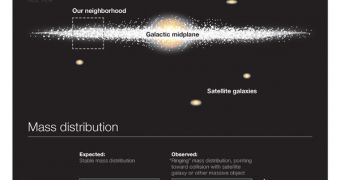An international collaboration of astronomers was recently able to determine that an object – most likely a dwarf galaxy – flew through the disk of the Milky Way around 100 million years ago, the last time this has been known to happen.
As a large spiral galaxy, the Milky Way is surrounded by a large number of satellites, of which only a few were imaged or otherwise observed directly. Gravitational interactions are exerted between all of these cosmic structures at all times, and sometimes the influences result in a collision or flyby.
This is exactly what American and Canadian scientists believe happened 100 million years ago. A study of our galaxy's disk around the solar system's neighborhood revealed evidence that a dwarf galaxy may have passed through the Milky Way a short while back.
These conclusions came from an in-depth study of how galaxies tend to form, evolve over time, and interact with each other. Our own galaxy is believed to have begun forming more than 9 billion years ago, and it definitely had its fair share of encounters, clashes and collisions during this time.
“We have found evidence that our Milky Way had an encounter with a small galaxy or massive dark matter structure perhaps as recently as 100 million years ago,” team member Larry Widrow explains.
“We clearly observe unexpected differences in the Milky Way’s stellar distribution above and below the galaxy’s mid-plane that have the appearance of a vertical wave – something that nobody has seen before,” adds the expert, who is a professor at the Queen’s University, in Canada.
This conclusion was reached after scientists at QU, the University of Kentucky, the University of Chicago, and the US Department of Energy's (DOE) Fermi National Accelerator Laboratory (Fermilab) analyzed data regarding 300,000 nearby stars, covered by the Sloan Digital Sky Survey (SDSS).
Theoretical models had suggested a certain distribution of stars in our galactic neighborhood, which was not observed in practice. The team found that nearby stars were moving up and down in respect to the galactic plane at a speed of around 20 to 30 kilometers (12.4 to 18.6 miles) per second.
“Our part of the Milky Way is ringing like a bell.But we have not been able to identify the celestial object that passed through the Milky Way,” adds Fermilab investigator, Brian Yanny.
“It could have been one of the small satellite galaxies that move around the center of our galaxy, or an invisible structure such as a dark matter halo,” he goes on to say, quoted by Astrobiology Magazine.
According to previous measurements, our galaxy's 100 billion stars weigh in excess of 300 billion solar masses. Most of this weight is accounted for by dark matter, both within the galaxy and in the massive halo surrounding it.

 14 DAY TRIAL //
14 DAY TRIAL //